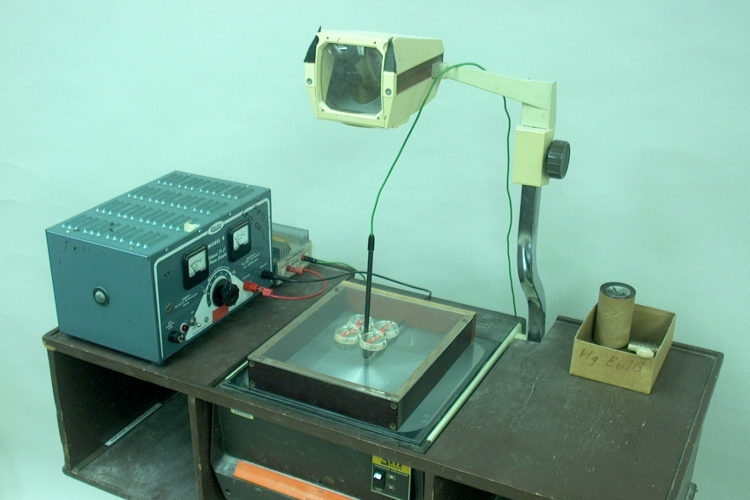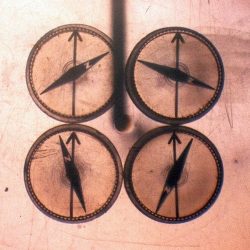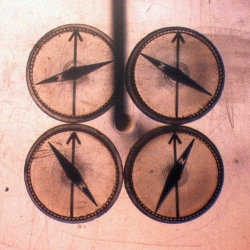
A video of this demonstration is available at this link.
Four compasses in transparent cases are placed symmetrically about a vertical metal rod that is affixed to a clear plastic sheet. When you turn on the power supply, the compass needles deflect so that they lie tangent to the magnetic field lines around the wire, pointing in the direction of the magnetic field (north; vide infra). If you reverse the current, the compass needles switch their direction. If you wish, you can remove the compasses, and sprinkle iron filings (in the can in the box at right) on the plastic sheet, to show the lines of the magnetic field around the current-carrying wire.
In 1820, Hans Christian Oersted – while performing a classroom demonstration! – discovered that a current in a wire produces a magnetic field around the wire. The relationship between this magnetic field and the current that produces it is given by Ampère’s law, which states ∮B · dl = μ0i, where dl is an element of a circular path around the wire, μ0 is the permeability constant, which equals 4π × 10-7 tesla·meter/ampere, and i is the current in the wire. By convention, current refers to the flow of positive charge, which is in the opposite direction to the flow of electrons. Evaluating the integral gives the magnitude of the magnetic field. ∮B · dl = (B)(2πr) = μ0i, or B = (μ0i/2πr). The right-hand rule (see demonstration 68.13 – Right-hand rule model) gives its direction. Place your right hand near the current-carrying wire, with the thumb pointing in the direction of the current. Now curl the fingers around the wire. Your fingertips point in the direction of the magnetic field (north).
The needle of a compass placed next to a current-carrying wire, with the pivot axis of the needle parallel to the wire as in this demonstration, rotates so that it points tangent to the magnetic field, in the direction of the field.
The photographs below show the orientations of the compass needles for both directions of current flow in the vertical metal rod. (Because of stray magnetic fields from the projector and the cart, the needles do not all point exactly tangent to the field, but they are close.)
Current flowing downward Current flowing upward Demonstration 68.15 – Compass and current-carrying wire, shows a current-carrying wire placed above a compass, so that it is perpendicular to the pivot axis of the needle.
As noted above, if you wish, you can sprinkle iron filings around the wire to show the lines of the magnetic field produced by the current flowing in the wire.
References:
1) Halliday, David and Resnick, Robert. Physics, Part Two, Third Edition (New York: John Wiley and Sons, 1977), pp. 746-749.

